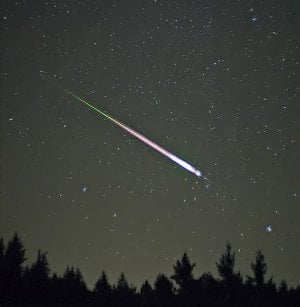Experience once-in-a-lifetime show as Australia’s skies will be showered in colourful lights!
By
Seia Ibanez
- Replies 20
As the night sky prepares to put on a spectacular show, Australians are in for a celestial treat with the return of something remarkable.
This isn't just any ordinary display of shooting stars; these streaks of light are known for their speed and brilliance, creating a cosmic light show that's truly a once-in-a-lifetime experience.
The Leonid meteor shower, which graces our skies annually, is set to peak on the nights of 17 and 18 November.
During this time, stargazers can expect to witness up to 15 meteors per hour, each one racing across the atmosphere at an astonishing 70 kilometres per second.
But what makes this meteor shower so special, and why does it produce such a vibrant spectacle?
Monash University astronomer Associate Professor Dr Michael Brown explained that the colours we see are a direct reflection of the meteor's composition.
'The colour reflects the composition of the meteor. So depending on what elements you have in the grain of dust that hits the atmosphere, you'll see that in the colours of the meteor,' he shared.
If you're wondering where to spot the Leonid meteor, using a smartphone app can help you locate Leo in the night sky, ensuring you're looking in the right direction.
‘They come in at 70 kilometres a second, so we can get some really bright meteors,’ Brown said.
But what exactly causes this annual meteoric event?
The Leonid shower results from Earth passing through the dust trail left by the comet Tempel-Tuttle.
‘So each year, when Earth passes through the comet’s orbit, we get a meteor shower,’ Brown said.
While most Leonid meteors are relatively small, with diameters ranging from 1 mm to 1 cm, they can still put on quite the show.
In fact, there have been instances where larger meteors have produced audible hissing sounds as they disintegrated.
Historical accounts, such as the 1833 storm, tell of up to 100,000 meteors per hour, and in 1966, thousands were observed in just 15 minutes.
Those who remember the 2002 Leonid storm recall the sky ablaze with clusters of bright green meteors.
However, this year's display may not be as intense. Such meteor storms occur approximately every 33 years when Earth passes through denser parts of the comet's dust trail.
The next such event is predicted for 2035.
You can also still catch other celestial events before the year ends!
In a previous story, some highlights of the celestial events of 2024 were listed—a perfect way to celebrate before the end of 2024. You can read more about it here.

Have you managed to catch the Leonid meteor shower or any celestial event? Share your experiences and any tips in the comments below!
This isn't just any ordinary display of shooting stars; these streaks of light are known for their speed and brilliance, creating a cosmic light show that's truly a once-in-a-lifetime experience.
The Leonid meteor shower, which graces our skies annually, is set to peak on the nights of 17 and 18 November.
During this time, stargazers can expect to witness up to 15 meteors per hour, each one racing across the atmosphere at an astonishing 70 kilometres per second.
But what makes this meteor shower so special, and why does it produce such a vibrant spectacle?
Monash University astronomer Associate Professor Dr Michael Brown explained that the colours we see are a direct reflection of the meteor's composition.
'The colour reflects the composition of the meteor. So depending on what elements you have in the grain of dust that hits the atmosphere, you'll see that in the colours of the meteor,' he shared.
If you're wondering where to spot the Leonid meteor, using a smartphone app can help you locate Leo in the night sky, ensuring you're looking in the right direction.
‘They come in at 70 kilometres a second, so we can get some really bright meteors,’ Brown said.
But what exactly causes this annual meteoric event?
The Leonid shower results from Earth passing through the dust trail left by the comet Tempel-Tuttle.
‘So each year, when Earth passes through the comet’s orbit, we get a meteor shower,’ Brown said.
While most Leonid meteors are relatively small, with diameters ranging from 1 mm to 1 cm, they can still put on quite the show.
In fact, there have been instances where larger meteors have produced audible hissing sounds as they disintegrated.
Historical accounts, such as the 1833 storm, tell of up to 100,000 meteors per hour, and in 1966, thousands were observed in just 15 minutes.
Those who remember the 2002 Leonid storm recall the sky ablaze with clusters of bright green meteors.
However, this year's display may not be as intense. Such meteor storms occur approximately every 33 years when Earth passes through denser parts of the comet's dust trail.
The next such event is predicted for 2035.
You can also still catch other celestial events before the year ends!
In a previous story, some highlights of the celestial events of 2024 were listed—a perfect way to celebrate before the end of 2024. You can read more about it here.
Key Takeaways
- The Leonid meteor shower, known for its speed and brilliance, is set to dazzle Australian skies with a peak expected on 17 and 18 November.
- Colours seen during the meteor shower reflect the composition of the meteors, with different elements creating various hues.
- Viewers are advised to find a dark location with minimal light pollution and may use phone apps to locate the constellation Leo, from where the meteors will appear to originate.
- This year's shower won't be as spectacular as the Leonid storm of 2002, with the next major event anticipated in 2035 due to the Earth passing through a denser part of the Comet Tempel-Tuttle's dust trail.









